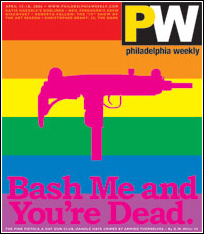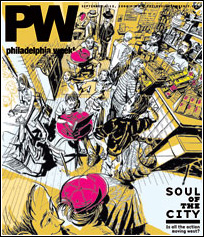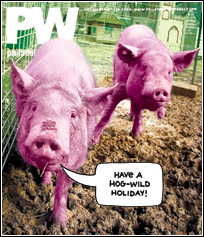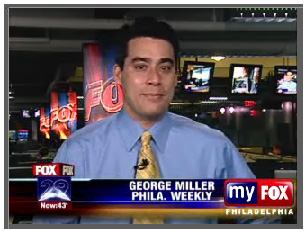Update for the Uptown
The Uptown Theater rises again.
From the June 24, 2009 Philadelphia Weekly.
Linda Richardson helped renovate five rowhomes across the street from the abandoned Uptown Theater during the early 1990s. Every day she worked there, she saw the disrespect heaped upon the once grand movie theater that was once the hub of the city's African-American pop culture scene.
Trash wafted all around. Graffiti scarred the walls. Posters were slapped on the plywood boarding up the old Art Deco palace, the former showcase for legendary R&B acts like Stevie Wonder, James Brown and Martha and the Vandellas.
"It was in a terrible state," says Richardson, former president and CEO of the African-American United Fund.
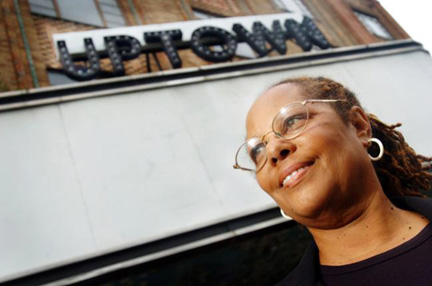
Closed as a performance space in 1981, the Uptown briefly reopened in the '80s. A church group held services there until a 1991 storm damaged the roof, allowing water to pucker the painted walls and corrode the gilded auditorium. After the congregation left, the only people who entered were thieves, crackheads and taggers.
Revival plans were hatched and shelved.
In 2001, Richardson helped purchase the landmark building just north of Susquehanna Avenue. It took eight years before she and her nonprofit group, the Uptown Entertainment and Development Corporation (UEDC), could raise the funds to repair the roof and stabilize the building.
After decades of decline, the next phase of the theater's rebirth will begin on June 27 - the official groundbreaking for the interior renovations.
"The redevelopment of the Uptown as an anchor for the community will reestablish this part of North Philly as a place where people can live, work, play and go to school," says Richardson, now the president and CEO of UEDC.
***
Given the violence and intense poverty in North Philly, it's easy to forget that the city's white privileged class once populated the area.
"In the late 1900s and early part of the 20th century, North Philadelphia was home to fashionable mansions of the upper and upper-middle class," says John Gallery, executive director of the Preservation Alliance. "Much of the area was built around the same time the Rittenhouse Square neighborhood was developed."
Executives from nearby factories lived in Victorian brownstones - some with turrets and mansard roofs - which lined the streets of North Philly.
Along Broad, you could find the grand mansions of famed industrialists -
Widener, Elkins and Burk, among others.
The elite dined and brokered deals inside magnificent gentlemen's clubs like the Mercantile and the Columbia Club. There was an opera house at Broad and Montgomery. A second was built a few blocks south.
The Uptown was created as a cinema for the new "talking pictures," entertainment for the nouveau riche. Unfortunately, it opened on the eve of the Great Depression in 1929.
***
As the wealthy white folks left in the '30s, black folks entered. Black doctors, lawyers, politicians and preachers took over the grand mansions along Diamond Street.
"If you were anybody of any station at all, you lived in that area," says Rev. Joe Williams, 70, who was raised near 18th and Diamond.
By the late 1950s, North Philadelphia was the epicenter of Philadelphia's
African-American community. It was a vibrant place populated by all classes - wealthy, middle class, working stiffs and the poor. There were dozens of factories, numerous clubs along Columbia Avenue, shops and restaurants all over the place, and the Uptown - which evolved into a mecca for live music.
"All the big acts came through the Uptown," says Williams, who occasionally performed with the Dixie Hummingbirds.
Ray Charles, Smokey Robinson, Marvin Gaye, Gladys Knight & the Pips, the Supremes and numerous other groups played the Uptown in its glory days. Fans circled the block to get in, and many stayed for multiple performances.
By the mid-1960s, however, affluent blacks started moving out of North Philly, following white flight to less densely populated areas. That left a gap in the community.
"You no longer saw people you could aspire to emulate," says Diane Turner, curator of the Blockson Afro-American Collection at Temple University.
Then came the riots and the manufacturing exodus of the '60s, and the gang wars of the '70s. By 1978, the 2,000-seat Uptown was too small for the major acts, in an area that was too sketchy.
The neighborhood lost its heart. Then the crack epidemic eroded its soul.
***
"It's not quite as daunting when you say you're doing something at Broad and Susquehanna as it was when we started this project," says Richardson. "The area is starting to emerge."
Temple students occupy more of the neighborhood near the theater, and there are recent commercial projects along North Broad - a movie complex and an incoming grocery store.
The UEDC has received pledges of $3.5 million but it will take around $8 million to get the facility fully operational.
By the fall of 2011, Richardson hopes the work will be done - office and education space, expansion of the auditorium seating, maybe a restaurant on the ground floor. She expects the facility to employ around 200 people and provide educational and job-training services to residents from the surrounding community.
"The Uptown rose as a place people could go and forget their problems," Richardson says. "We think we can create something similar there again."



